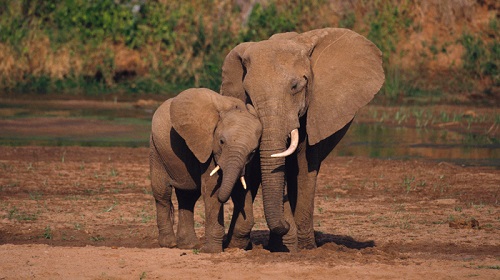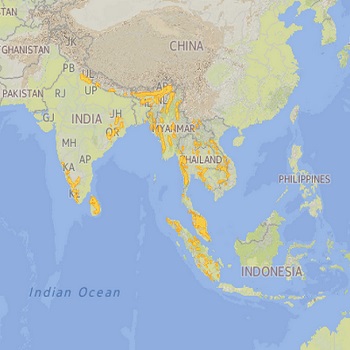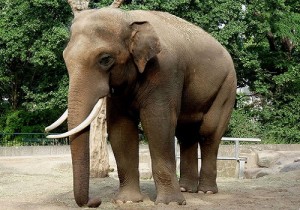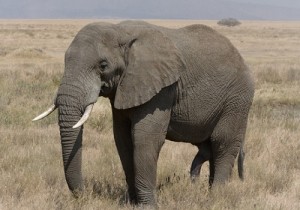Taxonomy
Kingdom |
Phylum |
Class |
Order |
Family |
Genera |
Animalia |
Chordata |
Mammal |
Proboscidea |
Elephantidae |
LoxodontaElephas |
0

African elephant mother and calf from Tembe Elephant Park in South Africa.
0
Distribution and Habitat
- There are two subspecies of elephants: African elephant (Loxodonta Africana) and Asian elephant (Eliphas maximus).
- African elephants are distributed throughout sub-Saharan Africa and found in 37 countries.
- Asian elephants are found throughout South Asia and Southeast Asia.
- Elephants need a vast habitat to survive. Their habitat includes savannas, deserts, rainforests and marshes near sources of water.
- Distribution of the Asian Elephant. Source: IUCN Red List of Threatened Species
- Distribution of the African Elephant. Source: IUCN Red List of Threatened Speceis
Physical Features
- Their most distinctive feature is their long trunk or proboscis which is used for picking up objects, touching, producing sounds and breathing. They can lift up to 770 lb or 350 kg and have as many as 150,000 muscle units.
- Elephant’s tusks are overgrown incisors in the upper jaw which serve as weapons or tools. They can reach up to 10 ft or 3 m long.
- Tusks grow continuously from the age of 6 months old at a rate of 7 in or 17 cm a year until the age of 20, then the growth rate slows down. Elephants have a dominant left or right tusk just like humans are right or left handed. The dominant tusk is shorter and its tip more rounded because it wears out.
- Their large ears are used to control their body temperature. They contain capillaries helping release heat.
- Elephants have 26 teeth. Their molars are replaced 6 times in their lifetime. In most animals teeth are produced from top to bottom but in elephants teeth are developed from the back pushing forward and replacing the front teeth.
- When the final molar starts to wear down it is difficult for elephants to chew food, many die of starvation or malnutrition at old age.
- They have very thick and tough skin especially on the back where it can be up to 1 in or 2.54 cm thick. Even though their skin is thick it is also very sensitive. They use mud as sunscreen and as insect repellent.
Difference between African and Asian elephants
- Asian Elephant
- African Elephant
African Elephant
- African elephants are the largest mammals on earth.
- They have larger ears than the Asian elephant and they are shaped like the continent of Africa.
- Males and females have visible tusks.
- Their skin is very wrinkly.
- They have a concave back.
- At the end of their trunk they have two finger-like extensions allowing them to pick food up.
- African elephants measure from 10 to 13 ft or 3 to 4 meters tall.
- They weigh from 8,800 to 15,400 lbs or 4,000 to 7,000 kg.
Asian Elephant
- They have smaller ears than the African elephant.
- Their skin is not as wrinkly.
- They have convex or level backs.
- Asian elephants have one “finger” at the end of their trunk.
- Only males have visible tusks. Females have very small ones or none at all.
- Asian elephants measure from 7 to 11 ft or 2 to 3.5 m tall.
- They weigh from 6,600 to 11,000 lbs or 3,000 to 5,000 kg.
Behavior
- Elephants are organized into complex social structures of females and calves forming strong bonds among its members. These groups are led by a matriarch.
- Females are known as “cows” and males as “bulls”
- Bulls leave their mothers when they are 14 or 15 years old. They may live alone or with other males.
- They roam in herds.
- Elephants sleep 3 to 4 hours a day.
- They spend an average of 16 hours a day eating.
- Elephants communicate by touching with their trunks and by producing sounds. They make sounds in low frequency so humans cannot hear some of them. They also growl and rumble.
Reproduction
- Elephants are polygynous meaning that they have several partners.
- They reach reproductive maturity between the ages of 10 and 12.
- Females give birth every 4 to 5 years to one calf, very rarely they will give birth to twins.
- Gestation period is 22 months, the longest of any mammal.
Calves
- Calves are born 33 in or 85 cm tall and with a weigh of around 260 lb or 120 kg.
- They exclusively consume their mother’s milk for the first 3 months. After that they start to eat vegetation and water in addition to their mother’s milk until they are 2 or 3 years old.
- They are dependent on their mother and other members of the herd.
- Males do not provide parental care.
- Calves are at risk of predation by hyenas, leopards, crocodiles and lions.
Diet
- Elephants are herbivorous and eat leaves, fruits, bark, roots and grass.
- They consume around 330 lb or 150 kg of food and 40 liters of water a day.
Life Expectancy
- Elephants can live for 60 to 70 years.
Threats
- Elephants need large amounts of food, water and land to survive and often come into conflict with humans for resources.
- Ivory trade.
Conservation Status
- The IUCN Red List of Threatened Species lists the African elephant as “vulnerable” while the Asian elephant as “endangered”
Fun Facts
- Elephants are closely related to the extinct mammoths that once roamed the Earth.
- Its closest living relatives are sea cows, golden moles and hyrax.
- Elephants are referred to as keystone species because they open up forests and help distribute fruit and shrub seeds, vital to the ecosystem.
- The elephant uses it trunk to transfer water to its mouth and not as a straw. It can hold up to 5 liter or 1.3 gallons of water.
- Because its trunk’s tip contains sensitive nerve endings elephants can detect vibrations of running animals by placing the tip of its tongue on the ground.
- Elephants inhale 70% of air through the trunk and 30% through the mouth.
- Fold in brain resembles that of humans.
References and further research
University of California Museum of Paleontology – The elephantidae
BBC Nature Wildlife – Elephants



